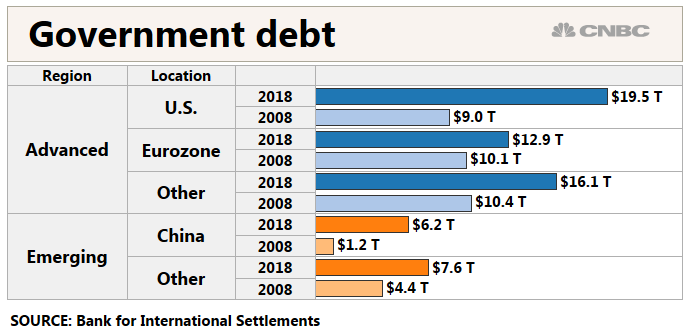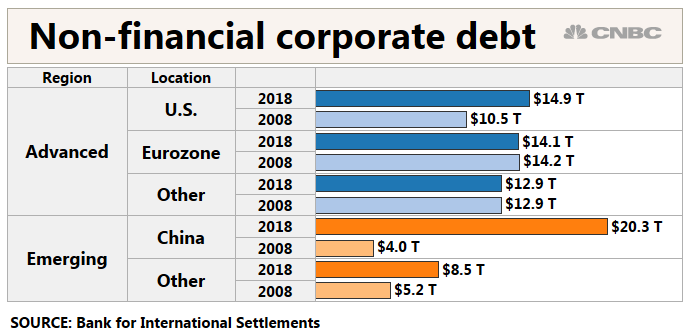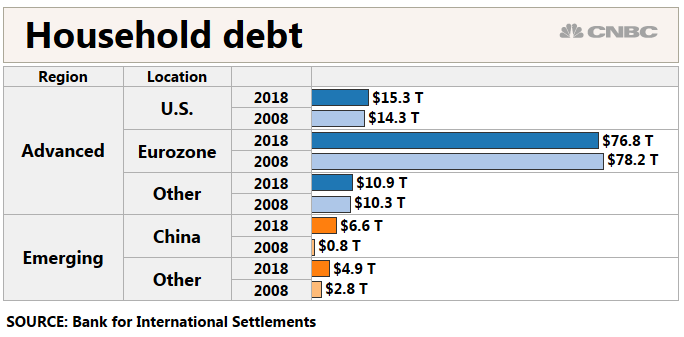Global debt has jumped since the financial crisis, though one ratings agency thinks that it poses significantly less danger than the last time around.
Corporate, government and household indebtedness rose to $178 trillion as of June 2018, a 50 percent increase from a decade ago, according to figures S&P Global Ratings released Tuesday. The expansion was especially acute at the government level, which stood at $62.4 trillion, or 77 percent higher than it did before the public borrowing binge began.
"Global debt is certainly higher and riskier today than it was a decade ago, with households, corporates, and governments all ramping up indebtedness," S&P Global Ratings credit analyst Terry Chan said in a statement. "Although another credit downturn may be inevitable, we don't believe it will be as bad as the 2008-2009 global financial crisis."

The lower danger level is due largely to the nature of the debt — primarily driven by government borrowing in sovereign countries rather than the private sector surge that led to the housing market collapse and the worst economic downturn since the Great Depression.
In addition, much of the gain on the corporate side came from Chinese companies who borrowed from domestic institutions, lowering the probability that defaults would cause global contagion.

"Despite higher leverage, the risk of contagion is mitigated by high investor confidence in major Western governments' hard currency debt. The high ratio of domestic funding for Chinese corporate debt also reduces contagion risk, because we believe the Chinese government has the means and the motive to prevent widespread defaults," S&P said.
The agency itself, along with competitors like Moody's and Fitch, came under fire after the crisis for not sounding alarms about the debt buildup.
During the crisis, big Wall Street firms issued securities composed of mortgage bonds that got high grades from the ratings agencies but eventually blew up and caused systemic damage that spread from the U.S. globally.
S&P cautioned that while the contagion risks are lower this time, dangers remain.
"While we believe contagion risk is lower than in 2008-2009, risks are elevated. Due to extremely low interest rates, the past decade has seen a migration of investor flows into speculative-grade and non-traditional fixed-income products," the agency said. "These markets tend to be less liquid and more volatile, and could seize in the event of a financial shock or panic."
However, while the level of debt has amped up considerably, the amount of leverage, or debt to GDP, is up less dramatically, from 208 percent in June 2008 to 231 percent in June 2018.
Households also have been more conservative. That's particularly true in the U.S., which showed a gain of just over $1 trillion during the decade to $15.3 trillion, just a 7 percent increase, or less than 1 percent a year. In China, that level has risen to $6.6 trillion, or 716 percent.

The euro zone also is notable for restraint, with total debt in all categories rising just 4 percent in the period to $34.7 trillion.
One of the areas of particular worry that S&P cited was corporate debt, especially on the lower end of the scale. On a global basis, companies have racked up $23.8 trillion since the crisis, an increase of 51 percent.
However, the triple-B category of near-junk debt showed a 170 percent gain since 2008, with analysts worried that "Fallen Angels," or companies that go from lower investment-grade to high-yield debt, could cause default problems if they aren't able to refinance.
In addition to the surging levels of low-grade debt, the amount of "covenant lite" leveraged loans — given to corporate borrowers with poor credit profiles with a low level of guarantees to investors — now make up 79 percent of the $1.14 trillion market. That poses a danger to collateralized loan obligations, which are packages of the loans that investors buy that were a significant component of the financial crisis problems.
S&P pointed out that defaults have been low in the risky part of the corporate bond market, thanks largely to easy-money and low interest rate policies at central banks. The Federal Reserve and its global counterparts have been normalizing policy over the past several years, potentially posing additional risks to low-grade debt.
No comments:
Post a Comment